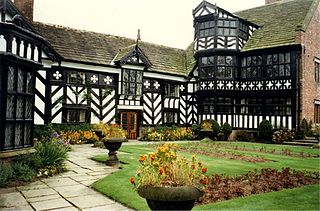
Gawsworth Old Hall is a Grade I listed country house in the village of Gawsworth, Cheshire, England. It is a timber-framed house in the Cheshire black-and-white style. The present house was built between 1480 and 1600, replacing an earlier Norman house. It was probably built as a courtyard house enclosing a quadrangle, but much of it has been demolished, leaving the house with a U-shaped plan.
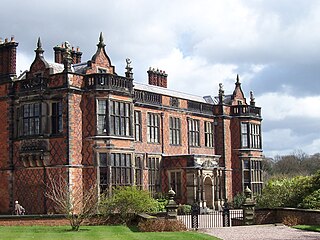
Arley Hall is a country house in the village of Arley, Cheshire, England, about 4 miles (6 km) south of Lymm and 5 miles (8 km) north of Northwich. It is home to the owner, Viscount Ashbrook, and his family. The house is a Grade II* listed building, as is its adjacent chapel. Formal gardens to the southwest of the hall are also listed as Grade II* on the National Register of Historic Parks and Gardens. In the grounds are more listed buildings, a cruck barn being listed as Grade I, and the other buildings as Grade II.
The Headstone Museum, also known as the Harrow Museum, is the local history museum for the London Borough of Harrow in England.
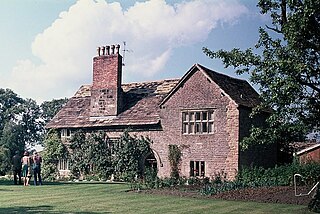
Chorley Old Hall is a moated manor house on the B5359 road to the southwest of Alderley Edge, Cheshire, England. The house is recorded in the National Heritage List for England as a designated Grade I listed building, and the moated site is a scheduled monument. It is the oldest inhabited country house in Cheshire and consists of two ranges, one medieval and the other Elizabethan.

Tatton Old Hall is a historic building in Tatton Park near Knutsford, Cheshire, England. It is designated by English Heritage as a Grade II* listed building which is owned by the National Trust and administered in conjunction with Cheshire East Council. It is also known as one of the most haunted houses in Britain and is home to The Haunted Hunts official haunted collection. Paranormal investigations take place on a monthly basis under the guidance of The Haunted Hunts team. Its site is a Scheduled Ancient Monument.
Poole Hall is a Regency mansion at Poole, near Nantwich in Cheshire, England. It dates from 1812 to 1817 and is recorded in the National Heritage List for England as a designated Grade II* listed building. Nikolaus Pevsner considered the interior to be "exceptionally fine". The hall is a private residence and is not open to the public.
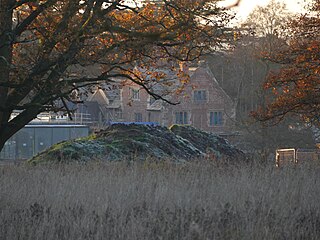
Alderley Old Hall is the remaining part of a former 17th-century manor house near the village of Nether Alderley, Cheshire, England. It stands adjacent to the mill pond of Nether Alderley Mill, a loop of which acts as a moat. The hall is recorded in the National Heritage List for England as a designated Grade II* listed building.
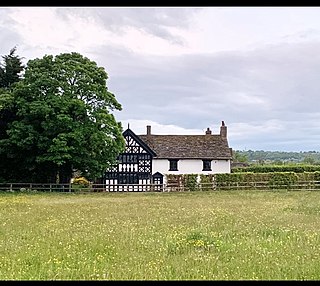
Duddon Old Hall is a country house in the village of Duddon, Cheshire, England. It dates from the later part of the 16th century, the house was in the ownership of the Done family at this time. Alterations and additions were made in the early 19th century, and later in the century the timber framing was restored in 1903–4 and these works may be associated to local architect John Douglas of Chester. The timber framing was most recently extensively repaired between September 2021 and April 2022. It is constructed partly in timber-framing, and partly in brick, on a stone plinth. It is roofed partly in stone-slate, and partly in Welsh slate. The plan consists of a hall with a cross wing. The house is in two storeys, and its south front has four bays. The bay at the left end is timber-framed; it projects and has a gable with a bargeboard. The architectural historian Nikolaus Pevsner comments that the black-and-white decoration of this bay is "very rich". It consists of studding in the ground floor, lozenges and shaped balusters in the upper floor, and lozenges and serpentine struts in the gable. In the adjacent bay is a wooden doorcase with a triangular pediment. All the windows are casements. Internally, the main chamber is in the cross wing, which is open to the roof. The house is recorded in the National Heritage List for England as a designated Grade II listed building. To the northeast of the house is a 16th-century barn, constructed in timber-framing with brick infill, which is also listed at Grade II.
Hampton Old Hall is a country house in the parish of No Man's Heath and District, Cheshire, England. It is dated 1591, and was built for the Bromley family. There have been subsequent additions and alterations. Figueirdo and Treuherz describe it as "a puzzling and ambitious house, perhaps never completed". The main block is the earliest section, and consists of a close-studded timber-framed range with three gables. Adjoining it is a 17th-century timber-framed porch. Behind the porch is a south wing in brick and stone. The architectural historian Nikolaus Pevsner comments "there must be quite an interesting story behind all this". The house has been "restored and furnished ... in a solid and traditional farmhouse manor". It is designated by English Heritage as a Grade II* listed building. A timber-framed barn to the north of the hall, dating from the 17th century, is listed at Grade II.

Lower Huxley Hall is a moated manor house in Cheshire, England, located about 6.5 miles (10 km) southeast of Chester. It lies roughly halfway between the villages of Huxley and Hargrave, It dates from the late 15th century, with major additions and alterations in the 17th century. A small addition was made to the rear in the 19th century. It was originally a courtyard house, but only two wings remain. The house is designated by English Heritage as a Grade II* listed building.
Lymm Hall is a moated country house in the village suburb of Lymm in Warrington, Cheshire, England. It is recorded in the National Heritage List for England as a designated Grade II* listed building.

Overton Hall is a country house in the parish of Malpas, Cheshire, England. The house originated in the middle of the 16th century on a moated site as a timber-framed great hall with a screens passage; it was built for the Alport family. The great hall has since been divided into two floors, and the house was externally refaced in the early 19th century by the Gregson family. Two of the faces of the house are timber-framed with painted brick nogging. The other faces are in brick with stone dressings. The roofs are slated with tiles on the ridges. The chimney stacks, porch and bay windows are in stone. The house is recorded in the National Heritage List for England as a designated Grade II listed building. To the south of the house is a stone bridge over the former moat dating from the 18th century. This is also listed at Grade II. Immediately to the east of the hall are the remains of a medieval and post-medieval settlement and field system that are recognised as a Scheduled Monument.

Swineyard Hall is a moated country house in the parish of High Legh, Cheshire, England. It was built in the 16th century, with additions made in the 19th century, and is still partly moated. The house is constructed partly in timber framing with rendered brick infill, and partly in stone on a brick plinth. The house has two storeys and an H-shaped plan. The left hand wing of the entrance front is timber-framed, and includes close studding. The house is recorded in the National Heritage List for England as a designated Grade II* listed building. The moated site on which the house stands is a Scheduled Monument.

The ruin of Tabley Old Hall is on an island surrounded by a moat in the civil parish of Tabley Inferior, about 1.5 miles (2.4 km) to the west of Knutsford, Cheshire, England. The ruin is recorded in the National Heritage List for England as a designated Grade II* listed building, and the moated site on which it stands is a scheduled monument.
Allostock is a civil parish in Cheshire West and Chester, England. It contains twelve buildings that are recorded in the National Heritage List for England as designated listed buildings. Of these, two are listed at Grade II*, namely Hulme Hall, and the bridge over its moat. The other buildings are all listed at Grade II. They are all domestic buildings, or related to farming, reflecting the rural nature of the parish.
Huxley is a former civil parish, now in the parishes of Hargrave and Huxley and Tattenhall and District, in Cheshire West and Chester, England. It contains four buildings that are recorded in the National Heritage List for England as designated listed buildings. Two of these are listed at Grade II*, the middle grade, and the other two are at the lowest grade, Grade II. Apart from the village of Huxley, the parish is entirely rural. The listed buildings consist of a former manor house on a moated site, a bridge across the moat, a farm building, and a canal bridge.
Plumley is a civil parish in Cheshire East, England. It contains seven buildings that are recorded in the National Heritage List for England as designated listed buildings. Of these, one is listed at Grade II*, the middle grade, and the others are at Grade II. The parish is mainly rural, and the listed buildings consist of farmhouses, a farm building, a cottage, a country house with a bridge giving access to it, and a public house.
Tabley Inferior is a civil parish in Cheshire East, England. It contains 14 buildings that are recorded in the National Heritage List for England as designated listed buildings. Of these, two are listed at Grade I, the highest grade, one is listed at Grade II*, the middle grade, and the others are at Grade II. Much of the parish is occupied by the estate of Tabley House, and 13 of the listed buildings are associated with it, the other listed building being a timber-framed house.
Haigh is a civil parish in the Metropolitan Borough of Wigan, Greater Manchester, England. It contains 30 listed buildings that are recorded in the National Heritage List for England. Of these, one is listed at Grade II*, the middle grade, and the others are at Grade II, the lowest grade. The parish contains the village of Haigh, the estate of Haigh Hall, and the surrounding countryside. The most important building in the parish is Haigh Hall; this and a number of buildings in the estate are listed. The Leeds and Liverpool Canal runs through the parish, and three bridges associated with it are listed. The other listed buildings include farmhouses, farm buildings, a set of stocks, houses, workers' cottages, a church and associated structures, a school, and a bridge over a disused railway.
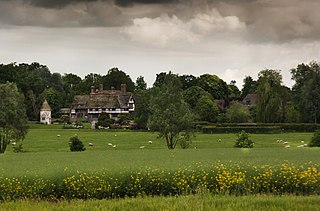
Crowhurst Place, Crowhurst, Surrey, England is a medieval hall house dating from the early 15th century. In the 20th century, the house was reconstructed and enlarged by George A. Crawley, firstly for himself and subsequently for Consuelo Vanderbilt, Duchess of Marlborough. It is a Grade I listed building.












